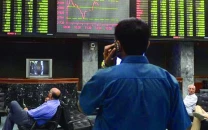SBP injects huge amount into banking system
It will encourage banks to lend more to meet govt’s needs

Pakistan’s central bank has injected a significantly large amount of Rs4.77 trillion into the banking system for up to four weeks to enable conventional and Shariah-compliant banks to meet the cash-strapped government’s financing needs.
Market talk suggests that the State Bank of Pakistan (SBP) supplied a huge liquidity despite excessive funds with commercial banks as increased liquidity would encourage them to lend more to the government at reduced rates.
Secondly, the central bank was signaling markets through the release of heavy financing that it may consider cutting its policy rate earlier than expected, potentially in December.
Pak-Kuwait Investment Company (PKIC) Head of Research Samiullah Tariq said the injection of new financing was directly linked to banks’ lending to the government via the purchase of sovereign debt securities like T-bills and Pakistan Investment Bonds (PIBs). “One of the primary objectives of the central bank is to bring down the cost of lending to the government,” he said.
The government’s reliance on bank loans has increased mainly due to payment of interest on debt estimated at Rs8.3 trillion for the current fiscal year. This is slightly lower than the Federal Board of Revenue’s full-year tax collection target of Rs9.4 trillion.
Read SBP, Arab Fund alliance to ease cross-border remittances
This means most of the revenue will go into debt servicing, leaving almost nothing for development projects and economic activities.
However, the likely reduction in policy rate from the record high of 22% will reduce the cost of debt servicing and create room for development expenditure.
The Ministry of finance, in its economic outlook for October 2023, said “debt servicing costs increased 45% in Q1 (Jul-Sept) to Rs1.4 trillion.” On the expenditure side, “the primary concern is the rise in the cost of servicing public debt, with the rise in SBP’s policy rate to 22% and weaker PKR (Pakistani rupee) fueling the increase in servicing costs.”
The central bank provided new financing at slightly over 22% rate of return to commercial and Shariah-compliant banks.
A leading analyst said the other day the revenue collection surged almost 28% to Rs2.75 trillion in Jul-Oct 2023, but remained low compared to the government’s requirement, increasing its reliance on borrowing.
Moreover, its reliance on domestic commercial debt has continued to remain high due to little inflows of foreign debt.
The outstanding commercial bank debt provided to the government stood at Rs23.23 trillion as on October 31, 2023. It represents 88% of total deposits of Rs26.39 trillion with banks, showing the investment-to-deposit ratio (IDR) was hovering around a new peak.
On the other hand, the advances-to-deposit ratio (ADR) – the banks’ credit to the private sector, shrank to around 45% in October compared to 50% in June as the additional tax on banks in case the ADR fell below 50% was withdrawn. It created room for banks to invest more in government papers and lend little to the private sector.
The SBP’s latest numbers released on Friday showed that the outstanding bank lending to the private sector stood at Rs11.89 trillion at the end of October 2023. At the same time, the deposits at banks grew almost 18% to Rs26.39 trillion in October compared to Rs22.41 trillion in the same month of last year.
PKIC’s Tariq said the recent crackdown on currency smugglers and hoarders had prompted businesses and people to park money in banks. Moreover, the banks were offering a higher rate of return on fixed deposits, which also encouraged many to put savings in fixed deposits.
Published in The Express Tribune, November 12th, 2023.
Like Business on Facebook, follow @TribuneBiz on Twitter to stay informed and join in the conversation.


















COMMENTS
Comments are moderated and generally will be posted if they are on-topic and not abusive.
For more information, please see our Comments FAQ